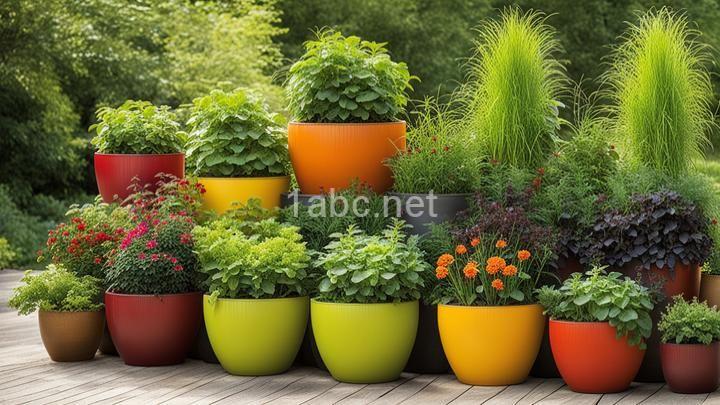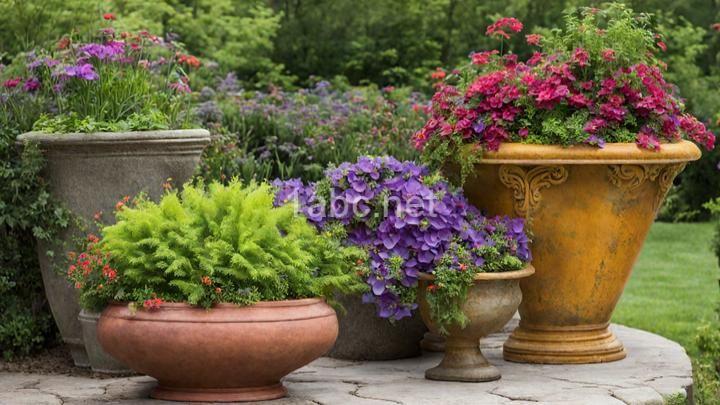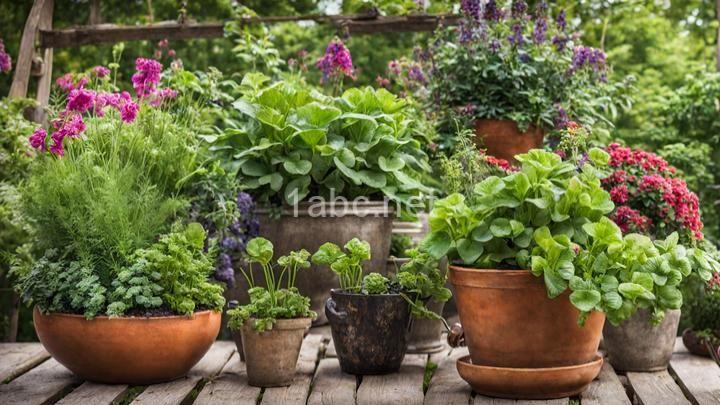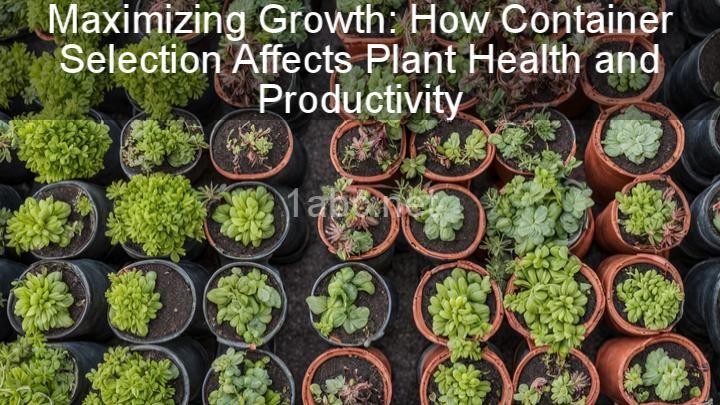Container Gardening for Small Spaces: Maximizing Your Garden with the Right Containers

Introduction:
Welcome to the world of container gardening! Whether you're a seasoned gardener or just starting out, container gardening is a fantastic way to bring life and beauty to even the tiniest of spaces. In this blog post, we will explore the ins and outs of container gardening for small spaces. So, grab your gardening gloves and let's get started!
I. Understanding Container Gardening:
To begin our container gardening journey, let's first define what exactly container gardening is. Container gardening is the practice of growing plants in pots, hanging baskets, or vertical planters, as opposed to planting them directly in the ground. It offers a multitude of advantages, especially for those with limited space.
One of the most significant benefits of container gardening is its flexibility. Whether you're living in a small apartment with no yard or have a compact balcony, container gardening allows you to create a lush garden oasis. Another advantage is the accessibility it offers. With containers, you can easily move your plants around to optimize sunlight exposure or protect them during extreme weather conditions.
When it comes to container gardening in small spaces, it's essential to choose the right containers. Pots, hanging baskets, and vertical planters are all excellent options. Consider the available space, sunlight levels, and the specific requirements of the plants you wish to grow. For example, herbs and vegetables often thrive in pots, while trailing flowers are perfect for hanging baskets.
II. Choosing the Right Plants:
Now that you have your containers ready, it's time to choose the right plants for your container garden. When it comes to container gardening in small spaces, selecting plants that are well-suited for containers is crucial. These plants typically have compact growth habits and don't require a lot of space to spread their roots.
Herbs are an excellent choice for container gardening. Not only do they add flavor to your meals, but they're also compact and easy to care for. Basil, rosemary, and mint are all great options. If you're a vegetable lover, consider growing cherry tomatoes, peppers, or lettuce in your containers. These vegetables thrive in pots and provide a bountiful harvest.
If you're new to gardening or prefer low-maintenance plants, there are plenty of options available. Succulents, such as jade plants or echeverias, are remarkably resilient and require minimal watering. Petunias and marigolds are also excellent choices for colorful blooms without too much fuss.
When selecting plants for your containers, make sure to match their sizes to the size of the container. A general rule of thumb is to choose plants that are no more than two-thirds the height of the container. This ensures that the plants have enough room to grow and flourish.
III. Preparing Your Containers:
Before you dive into planting, it's important to prepare your containers properly. Start by cleaning them thoroughly to remove any dirt or debris from previous use. This will help prevent the spread of diseases and ensure a fresh start for your plants.
Next, ensure that your containers have proper drainage holes. Without adequate drainage, excess water can accumulate, leading to root rot and other issues. If your containers don't have drainage holes, you can easily create them using a drill or hammer and nail.
In container gardening, using the right soil mixture is crucial for the health and growth of your plants. Look for a high-quality potting mix that is well-draining and rich in organic matter. Avoid using garden soil, as it tends to become compacted in containers and can hinder root growth.
To provide your plants with the necessary nutrients, consider adding some fertilizer and organic matter to the soil. This will promote healthy growth and ensure your plants have the best chance of thriving in their confined spaces.
IV. Planting and Care Tips:
With your containers prepared, it's time to plant your seeds or transplant seedlings into their new homes. Follow the instructions on the seed packets or transplanting labels to ensure proper spacing and depth. Be gentle with the roots to avoid damaging them during the planting process.
Watering is a crucial aspect of container gardening. Since containers tend to dry out more quickly than garden beds, it's important to water regularly. However, be careful not to overwater, as this can lead to root rot. The best way to determine if your plants need water is to stick your finger about an inch into the soil. If it feels dry, it's time to water.
In addition to watering, it's important to maintain a healthy environment for your container garden. Regularly prune your plants to remove dead or damaged leaves and encourage new growth. Implement pest control measures, such as using organic sprays or attracting beneficial insects, to keep unwanted visitors at bay. Disease prevention is also crucial, so be sure to monitor your plants for any signs of illness and take immediate action.
To maximize space in your container garden, consider utilizing vertical gardening techniques or companion planting. Vertical gardening involves growing plants vertically using trellises or stakes, making the most of your vertical space. Companion planting involves pairing plants that benefit each other, such as planting marigolds with tomatoes to deter pests.
V. Designing Your Container Garden:
Now that you have the basics of container gardening down, let's talk about designing your container garden. Don't be afraid to get creative and have fun with the arrangement of your plants. Consider color combinations to create visually appealing displays. Mix different heights to add depth and interest to your containers.
To take your container garden to the next level, incorporate decorative elements like trellises or ornamental accents. A beautiful trellis can provide support for climbing plants and become a focal point in your garden. Decorative accents, such as colorful stones or garden statues, can add personality and charm to your containers.
Conclusion:
Congratulations! You've now learned the ins and outs of container gardening for small spaces. We've explored the benefits, plant selection, container preparation, planting and care tips, and even touched on designing your container garden. Container gardening is a fantastic way to bring life and beauty to even the smallest of spaces.
Now, it's time for you to take the plunge and start your own container garden. Whether you're growing herbs, vegetables, or flowers, container gardening offers endless possibilities. So, grab your containers, choose your plants, and let your gardening journey begin. Happy gardening!
FREQUENTLY ASKED QUESTIONS
Why should I consider container gardening for small spaces?
Container gardening is a fantastic option for small spaces for several reasons. Firstly, it allows you to maximize the limited space you have available. With containers, you can easily place them on balconies, patios, or even windowsills, making it possible to grow plants in spaces that may not have been suitable for traditional gardens.Secondly, container gardening is incredibly versatile. You have the freedom to choose from a wide variety of containers, ranging from pots and planters to hanging baskets and window boxes. This flexibility enables you to create a visually appealing garden that suits your style and preferences.
Another advantage of container gardening is the ability to control the environment for your plants. You can select the ideal soil, provide adequate drainage, and adjust the watering and sunlight levels to meet the specific needs of each plant. This level of control allows you to optimize the growing conditions and increase the chances of success.
Additionally, container gardening offers the convenience of easy maintenance. With a smaller area to tend to, it becomes more manageable to water, fertilize, and prune your plants. This can be particularly beneficial for individuals with busy schedules or limited mobility.
Furthermore, container gardening provides the opportunity to grow a wide range of plants, including flowers, herbs, vegetables, and even small fruit trees. You can create a diverse and vibrant garden that not only enhances the beauty of your space but also provides you with fresh produce or aromatic herbs for cooking.
Lastly, container gardening allows for flexibility and experimentation. If you decide to change the layout or move your plants around, it's as simple as rearranging the containers. This adaptability makes it easier to try out different combinations and arrangements until you find what works best for you.
In conclusion, container gardening is an excellent choice for small spaces. It maximizes the use of limited area, offers versatility, allows for better control of the environment, is easy to maintain, and provides the opportunity for a diverse range of plants. So, if you're looking to bring the joy of gardening to your small space, container gardening is definitely worth considering.
What are the benefits of container gardening?
Container gardening offers numerous benefits for both experienced gardeners and those new to gardening. Here are some of the key advantages:
-
Versatility: Container gardening allows you to grow plants in different types of containers, such as pots, baskets, or even old buckets. This flexibility lets you garden in small spaces, like balconies or patios, or even indoors if you lack a yard. You can easily move the containers around to optimize sunlight exposure and experiment with different plant combinations.
-
Accessibility: If you have physical limitations or difficulty bending down, container gardening eliminates the need for excessive bending or kneeling. The containers can be placed at a height that is comfortable for you, making it easier to tend to your plants, water them, and harvest the produce.
-
Pest control: Since containers are elevated from the ground, they can help reduce the risk of common garden pests, such as slugs or snails, accessing your plants. You can also monitor and control pests more effectively, as you can inspect each plant individually.
-
Soil control: Container gardening allows you to have complete control over the soil composition. This is particularly beneficial if you live in an area with poor soil quality, as you can choose the appropriate potting mix for each plant's specific needs. You can also easily amend the soil as needed to maintain optimal conditions for plant growth.
-
Weed management: Container gardening significantly reduces the occurrence of weeds. By using fresh, weed-free potting soil and regularly inspecting your plants, you can minimize the chances of weeds invading your containers. This saves you time and effort spent on weeding, allowing you to focus on the enjoyment of gardening instead.
-
Season extension: Containers can be moved indoors during colder seasons, extending the growing season for certain plants. This is especially useful if you live in a region with a short growing season or experience frost. You can continue to enjoy fresh herbs, vegetables, or flowers even when it's too cold outside.
-
Aesthetics: Container gardening provides an opportunity to showcase your creativity and enhance the visual appeal of your outdoor or indoor spaces. You can mix and match colorful containers, choose plants with different foliage textures, and create stunning arrangements that complement your personal style and preferences.
Remember, the benefits of container gardening are not limited to these points. The joy of watching your plants thrive and the satisfaction of growing your own food can also contribute to improved mental well-being and a sense of accomplishment. So, grab a container, select your favorite plants, and start enjoying the rewards of container gardening!
What types of plants can I grow in containers?
When it comes to growing plants in containers, the options are quite diverse. You can grow various types of plants, including flowers, herbs, vegetables, and even small fruit trees. The key is to choose plants that are well-suited for container gardening. Here are some popular choices:
-
Flowers: Petunias, geraniums, marigolds, pansies, and impatiens are all excellent choices for container gardening. They add a splash of color and beauty to any space.
-
Herbs: Basil, rosemary, thyme, parsley, and mint are just a few examples of herbs that thrive in containers. They are not only useful for cooking but also add a delightful fragrance to your surroundings.
-
Vegetables: Tomatoes, peppers, lettuce, spinach, and radishes are among the many vegetables that can be successfully grown in containers. Just make sure to choose compact varieties that are suitable for small spaces.
-
Small fruit trees: If you have enough space and sunlight, you can even grow small fruit trees in containers. Citrus trees, such as lemons or oranges, and dwarf apple or cherry trees are great options.
Remember to choose containers with proper drainage and use high-quality potting soil to ensure your plants thrive. Additionally, consider the specific sunlight, water, and temperature requirements for each plant to provide the optimal growing conditions. Happy gardening!
Do I need to use specific containers for container gardening?
In container gardening, using specific containers can be beneficial for the health and success of your plants. While it's not mandatory, using appropriate containers can provide the necessary conditions for your plants to thrive.Here are a few considerations when choosing containers for your container gardening:
-
Size: Ensure that your containers are large enough to accommodate the root system of the plants you intend to grow. Plants with larger root systems will require bigger containers to allow for proper growth.
-
Drainage: Good drainage is crucial to prevent waterlogging and root rot. Look for containers with drainage holes at the bottom to allow excess water to escape. If your chosen containers don't have pre-drilled holes, you can make them yourself.
-
Material: Containers can be made of various materials, such as plastic, clay, ceramic, wood, or metal. Each material has its pros and cons. Plastic containers are lightweight and retain moisture well, while clay or ceramic containers are heavier and may require more frequent watering. Wooden containers can provide excellent insulation but may need to be treated to resist rotting.
-
Insulation: Consider the insulation properties of the containers, especially if you live in an area with extreme temperatures. Some materials, like clay and ceramic, offer better insulation for the plant roots.
-
Aesthetics: Choose containers that complement your personal style and the overall design of your garden. There are countless options available, from traditional terracotta pots to modern and vibrant plastic containers.
Remember, the most important factor is to choose containers that meet the specific needs of your plants and provide a healthy growing environment. Happy gardening!


